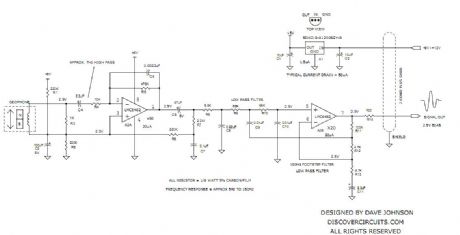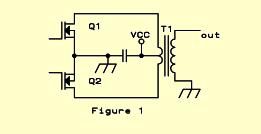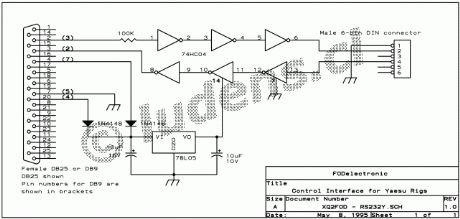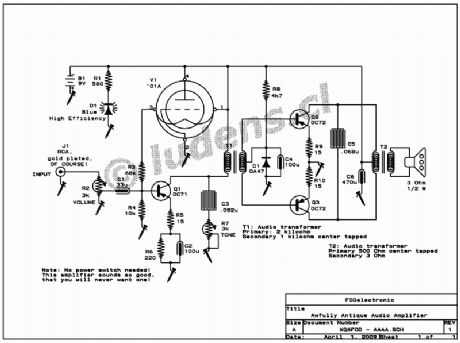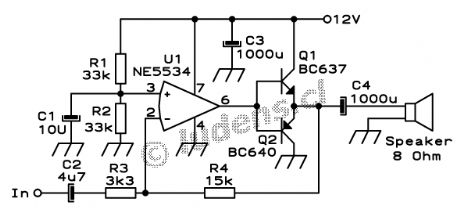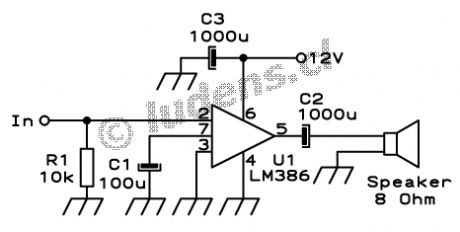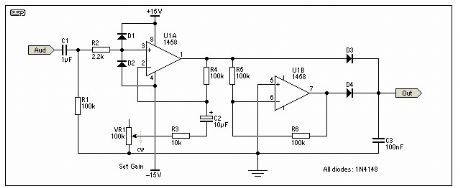
Amplifier Circuit
Index 8
Video amplifier
Published:2013/5/14 22:52:00 Author:muriel | Keyword: Video amplifier
View full Circuit Diagram | Comments | Reading(0)
GEOPHONE FOOTSTEP DETECTOR PREAMP
Published:2013/5/14 22:03:00 Author:muriel | Keyword: GEOPHONE FOOTSTEP DETECTOR PREAMP
View full Circuit Diagram | Comments | Reading(2581)
The 80 Watt power amplifier
Published:2013/5/9 21:25:00 Author:muriel | Keyword: The 80 Watt power, amplifier
View full Circuit Diagram | Comments | Reading(1931)
Voice identifier for a repeater station
Published:2013/5/9 21:24:00 Author:muriel | Keyword: Voice identifier, repeater station
View full Circuit Diagram | Comments | Reading(1078)
The Kenwood TS-450
Published:2013/5/9 21:21:00 Author:muriel | Keyword: The Kenwood TS-450
View full Circuit Diagram | Comments | Reading(1190)
conventional class AB push-pull amplifiers
Published:2013/5/9 21:20:00 Author:muriel | Keyword: conventional , class AB , push-pull amplifiers
View full Circuit Diagram | Comments | Reading(891)
FodTrack 2
Published:2013/5/9 21:18:00 Author:muriel | Keyword: FodTrack
View full Circuit Diagram | Comments | Reading(732)
FodTrack
Published:2013/5/9 21:18:00 Author:muriel | Keyword: FodTrack
View full Circuit Diagram | Comments | Reading(860)
The Awfully Antique Audio Amplifier
Published:2013/5/9 21:15:00 Author:muriel | Keyword: The Awfully Antique, Audio Amplifier
View full Circuit Diagram | Comments | Reading(1423)
12V powered, 4x15 Watt quad amplifier
Published:2013/5/9 21:15:00 Author:muriel | Keyword: 12V powered, 4x15 Watt, quad amplifier
View full Circuit Diagram | Comments | Reading(1311)
Small audio amplifiers 3
Published:2013/5/9 21:14:00 Author:muriel | Keyword: Small audio amplifiers
View full Circuit Diagram | Comments | Reading(1115)
Small audio amplifiers 2
Published:2013/5/9 21:14:00 Author:muriel | Keyword: Small audio amplifiers
View full Circuit Diagram | Comments | Reading(914)
Small audio amplifiers
Published:2013/5/9 21:14:00 Author:muriel | Keyword: Small audio amplifiers
View full Circuit Diagram | Comments | Reading(923)
EL84/6BQ5 Tube Amplifier
Published:2013/4/27 22:01:00 Author:muriel | Keyword: EL84/6BQ5, Tube Amplifier

When experimenting with tube amplifiers, you might be confused about the different modes of operation, like triode or pentode mode. Here is the developed circuits which you can build small Amplifiers based on 6P14/6BQ5/EL84 easily, and the output Power of 2.6 Watts is more than enough for home use. Also,the PCB included.With this PCB you can try out the different Modes by means of Jumper Wires. (View)
View full Circuit Diagram | Comments | Reading(2533)
6SL7 SRPP / KT77 SIPP TUBE AMP
Published:2013/4/27 21:59:00 Author:muriel | Keyword: 6SL7 SRPP , KT77 SIPP, TUBE AMP

This circuit designed by Bruce and he has followed up his “OddWatt” project (EL84/6BQ5 Push-Pull) with the Oddwatt 225. The Oddwatt 225 is a scalable tube amplifier which will work with a number of octal tubes. In this build the driver stage is an SRPP with 6SL7 tubes and the output stage is a Class A UL SIPP with KT77 tubes. LM317 Regulators are used for the cathode CCS. (View)
View full Circuit Diagram | Comments | Reading(2984)
Simple Full Wave Rectifier and Preamp
Published:2013/4/26 1:48:00 Author:muriel | Keyword: Simple Full Wave, Rectifier and Preamp
View full Circuit Diagram | Comments | Reading(1357)
CMoy Pocket Amplifier
Published:2013/4/26 1:33:00 Author:muriel | Keyword: CMoy Pocket Amplifier
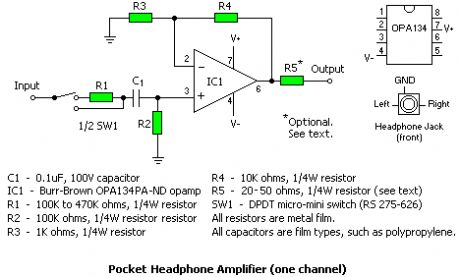
This is a very simple headphone amplifier designed by CMoy.Each channel uses a single Burr-Brown OPA134 opamp in a non-inverting configuration. It has adequate current capability to drive most headphones without an output stage.The amplifier is ideal as a booster for power-conserving stereo sources such as portable CD players and for interfacing with passive EQ networks such as tone controls or a headphone acoustic simulator. (View)
View full Circuit Diagram | Comments | Reading(2403)
Class A Headphone Amplifier
Published:2013/4/26 1:32:00 Author:muriel | Keyword: Class A , Headphone Amplifier
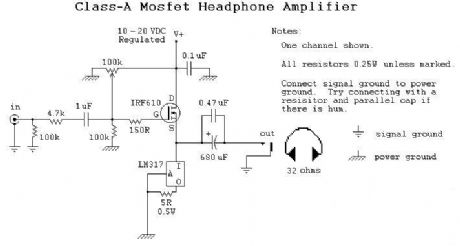
This is a simple do-it-yourself (DIY) headphone amplifier project that is fashioned primarily after the Class A MOSFET Headphone Driver project by Greg Szekeres and to some extent Mark’s DIY Class A 2SK1058 MOSFET Amplifier Project. The amplifier concept is simple and follows a typical single-ended class A circuit utilizing an active constant current source (CCS) in place of a passive resistor. A CCS doubles the efficiency of the circuit over that where a passive load resistor is used, bringing it to a maximum of 25%. (View)
View full Circuit Diagram | Comments | Reading(3510)
PPA headphone amplifier
Published:2013/4/26 1:29:00 Author:muriel | Keyword: PPA headphone amplifier

The PPA is a high-end headphone amplifier that works for both stationary and “transportable” amplifiers. There is a high-capacity fast-charging NiMH battery supply available, allowing excellent sonics without sacrificing run time despite the PPA amp’s hunger for power. While only the most dedicated audiophile would take it jogging with their iPod, this combination makes for a fine travel amplifier.
(View)
View full Circuit Diagram | Comments | Reading(2112)
2-20 Watt Stereo Audio Power Amplifier by LM1875
Published:2013/4/26 1:21:00 Author:muriel | Keyword: 2-20 Watt , Stereo, Audio, Power Amplifier , LM1875

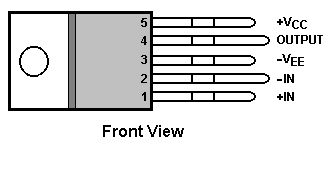
There are many instances where a simple and reliable power amplifier is needed - rear and centre channel speakers for surround-sound, beefing up the PC speakers, low powered tweeter amplifier, etc. For those who want to build their own 'Gainclone' amplifier, this will certainly do the job :-)
This project (unlike most of the others, but in a similar vein to Project 19) is based almost directly on the typical application circuit in the National Semiconductor specification sheet. You can also use the TDA2050 (from SGS-Thompson), which has almost identical performance and (remarkably) the same pinouts! As it turns out, the amp in the NS application circuit is pretty good, as is the (very similar) one from SGS. The amp is also remarkably simple to build - if you have a PCB! These ICs are a cow to wire on Veroboard - it is possible, but results are unpredictable.
Figure 1 shows the schematic - this is almost the same as in the application note (redrawn), and with added RF protection at the input. Note that the speaker must return to the central 'star' earth (ground) point. If connected to the amplifier's earth bus, you will get oscillation and/or poor distortion performance.
Voltage gain is 27dB as shown, but this can be changed by using a different value resistor for the feedback path (R4, currently 22k, between pins 2 and 4). The amplifier must not be operated at any gain less than 10 (20dB) as set by R4 and R5, as it will oscillate. In some cases, an inductor may be needed in series with the output to prevent instability with capacitive loads (10 turns of 0.5mm wire wound around a 10 Ohm 1W resistor). The most common capacitive load is the speaker cable itself, and 'audiophile' leads are often worse than standard grade cables in this respect.
The 1 Ohm resistor (R6) should be a 1W or 0.5W type, and all others should be 1/4W 1% metal film (as I always recommend). All electrolytic capacitors should be rated at 50V if at all possible, and the 100nF (0.1uF) caps for the supplies should be as close as possible to the IC to prevent oscillation. C1 should be a bipolar (non-polarised) electrolytic, or may be plastic film if you prefer.
The supply voltage should be about ±25 Volts at full load, which will let this little guy provide a maximum of 25 Watts (rated minimum output at 25°C). To enable maximum power, it is important to get the lowest possible case to heatsink thermal resistance. This will be achieved by mounting with no insulating mica washer, but be warned that the heatsink will be at the -ve supply voltage and will have to be insulated from the chassis. For more info on reducing thermal resistance, read the article on the design of heatsinks - the same principles can be applied to ICs - even running in parallel. I haven't tried it with this unit, but it is possible by using a low resistance in series with the outputs to balance the load.
Note that the supply voltage must not exceed ±30V at any time - this is the absolute maximum voltage rating for the LM1875. Note that the TDA2050 is rated for a maximum of ±25V.
Figure 2 shows the pinouts for the LM1875, and it should be noted that the pins on this device are staggered to allow adequate sized PCB tracks to be run to the IC pins.
The PCB for this amp is for a stereo amplifier, is single sided, and supply fuses are located on the PCB. The entire stereo board including four fuses is 115mm x 40mm (i.e. really small). The heatsink needs to be bigger than you might expect, largely because of the relatively high thermal resistance of the TO-220 case. National recommend that the heatsink should be no smaller than 1.2°C / Watt (it is actually suggested that the heatsink be 0.6°C / W, but this is a very large heatsink indeed, and is not necessary for normal audio into reasonably well behaved loads.
Never operate these ICs with no heatsink, even without any load connected. The quiescent dissipation will cause them to overheat very quickly, and may damage the internal circuitry.
Output power is rated at 20W per channel, but with music signals you will probably be able to get a peak power of about 25W into an 8 ohm load. Refer to the data sheet (see link below) for the full specification on the IC. Note that the TDA spec sheet claims 50W, but this is overly optimistic and cannot be achieved in practice.
(View)
View full Circuit Diagram | Comments | Reading(2785)
| Pages:8/250 1234567891011121314151617181920Under 20 |
Circuit Categories
power supply circuit
Amplifier Circuit
Basic Circuit
LED and Light Circuit
Sensor Circuit
Signal Processing
Electrical Equipment Circuit
Control Circuit
Remote Control Circuit
A/D-D/A Converter Circuit
Audio Circuit
Measuring and Test Circuit
Communication Circuit
Computer-Related Circuit
555 Circuit
Automotive Circuit
Repairing Circuit

